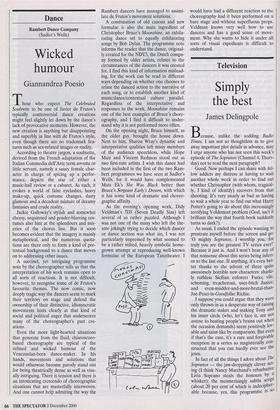Dance
Rambert Dance Company (Sadler's Wells)
Wicked humour
Giannandrea Poem
Those who expect The Celebrated Soubrette to be one of Javier de Frutos's typically controversial dance creations might feel slightly let down by the dance's lack of provocative moments. However, the new creation is anything but disappointing and superbly in line with de Frutos's style, even though there are no trademark fea- tures such as sex-related images or nudity.
According to theatre jargon, a soubrette, derived from the French adaptation of the Italian Commedia dell'Arte term servetta or little servant, namely a saucy female char- acter in charge of spicing up a perfor- mance, depicts the star of either a music-hall review or a cabaret. As such, it evokes a world of false eyelashes, heavy make-up, quick costume changes, dusty glamour and a decadent mixture of dreamy fantasies and crude reality.
Jackie Galloway's stylish and somewhat cheesy, sequinned and gender-blurring cos- tumes also hint at the splendours and mis- eries of the chorus line. But it soon becomes evident that the imagery is mainly metaphorical, and the numerous quota- tions are there only to form a kind of pre- textual background to a dance that moves on to addressing other issues.
A succinct, yet intriguing programme note by the choreographer tells us that the interpretation of his work remains open to all sorts of reactions. It is not difficult, however, to recognise some of de Frutos's favourite themes. The now comic, now deeply tragic way the dancers seem to mark their territory on stage and defend the ownership of their distinctive, idiosyncratic movements hints clearly at that kind of social and political anger that underscores many of the choreographer's past cre- ations.
Even the more light-hearted situations that generate from the fluid, chiaroscuro- based choreography are typical of the refined and wicked humour of the Venezuelan-born dance-maker. In his hands, movements and solutions that would otherwise become parody stand out for being theatrically dense as well as visu- ally intriguing. There is tension and there is an intoxicating crescendo of choreographic situations that are masterfully interwoven. And one cannot help admiring the way the Rambert dancers have managed to assimi- late de Frutos's movement solutions.
A combination of old canons and new formulae is also the main ingredient of Christopher Bruce's Moonshine, an exhila- rating dance set to equally exhilarating songs by Bob Dylan. The programme note informs the reader that the dance, original- ly created for the NDT3, the Dutch compa- ny formed by older artists, relates to the circumstances of the dancers it was created for. I find this kind of information mislead- ing, for the work can be read in different ways depending on whether one chooses to relate the danced action to the narrative of each song, or to establish another kind of music/dance/contextual culture parallel. Regardless of the interpretative and responses to the work, Moonshine remains one of the best examples of Bruce's chore- ography, and I find it difficult to under- stand why it is not performed more often.
On the opening night, Bruce himself, as the older guy, brought the house down. Next to him, Sharon Wray's dynamic and interpretative qualities left many members of the audience speechless, while Hope Muir and Vincent Redmon stood out as two first-rate artists. I wish this dance had been included in the first of the two Ram- bert programmes we have seen at Sadler's Wells, for it would have complemented Mats Ek's She Was Black better than Bruce's Sergeant Early's Dream, with which it has some kind of dramatic and choreo- graphic affinity.
As the evening's opening work, Didy Veldman's 7DS (Seven Deadly Sins) left several of us rather puzzled. Although I was not one of the many who left the the- atre jokingly trying to decide which dancer or dance section was what sin, I was not particularly impressed by what seemed to be a rather stilted, heavily symbolic home- grown attempt at reproducing well-known formulae of the European Tanztheater. I would have had a different reaction to the choreography had it been performed on a bare stage and without superfluous props. Veldman knows very well how to use dancers and has a good sense of move- ment. Why she wants to hide it under all sorts of visual expedients is difficult to understand.


















































































 Previous page
Previous page